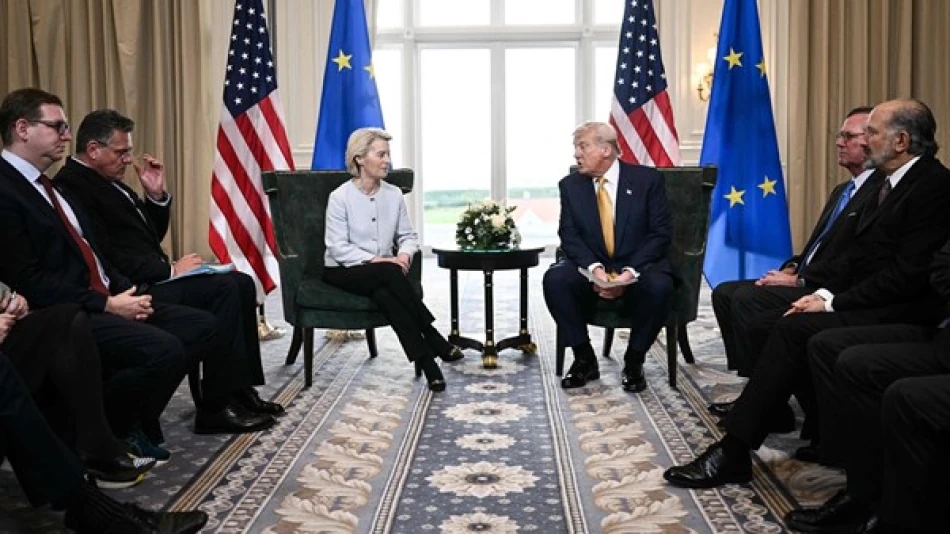
Historic US-EU Trade Deal Reached, Unlocking Vast Economic Opportunities
Trump Claims Breakthrough Trade Deal with EU, Ending Years of Tariff Tensions
President Donald Trump announced Sunday that he has reached a comprehensive trade agreement with the European Union that would resolve longstanding tariff disputes, following a meeting with European Commission President Ursula von der Leyen in Scotland. The surprise announcement, if substantiated, could reshape global trade dynamics and provide relief to businesses caught in the crossfire of transatlantic economic tensions.
The Scotland Summit: A Diplomatic Surprise
Speaking to reporters after his discussions with von der Leyen in Turnberry, Trump declared: "We have reached an agreement. It's a good deal for everyone." The EU Commission President echoed the sentiment, describing the deal as "good," though neither leader provided specific details about the agreement's terms or implementation timeline.
The choice of Scotland as a meeting venue appears strategic, offering a neutral ground away from the formal diplomatic channels of Washington or Brussels. This informal setting may have facilitated more flexible negotiations than traditional trade summits typically allow.
Breaking Years of Trade Gridlock
The Tariff War Background
The EU-US trade relationship has been strained for years over competing tariffs on steel, aluminum, and agricultural products. Trump's previous administration imposed significant tariffs on European goods, citing unfair trade practices, while the EU retaliated with its own levies on American products ranging from bourbon to motorcycles.
These trade barriers have cost businesses on both sides of the Atlantic billions in additional costs, with European manufacturers of steel and aluminum particularly hard hit, while American exporters of agricultural products and consumer goods faced reduced market access.
Economic Stakes and Market Implications
The transatlantic trade relationship represents over $1.3 trillion in annual commerce, making it one of the world's most significant economic partnerships. A comprehensive tariff resolution could unlock substantial economic value for both regions, particularly benefiting manufacturing sectors that have faced elevated input costs due to steel and aluminum tariffs.
For investors, this development signals potential relief for multinational corporations with significant EU-US exposure. Industrial companies, agricultural exporters, and consumer goods manufacturers could see improved profit margins if tariff burdens are reduced or eliminated.
Global Trade Realignment
Comparison to Other Trade Deals
This announcement follows a pattern of Trump's preference for bilateral negotiations over multilateral trade frameworks. Unlike the comprehensive trade agreements seen with countries like Singapore or the UAE's economic partnerships, the EU-US deal appears focused specifically on tariff resolution rather than broader economic integration.
The approach contrasts sharply with the EU's typical preference for detailed, legally binding trade agreements that undergo extensive parliamentary review. The informal nature of this announcement suggests either a preliminary framework agreement or a significant departure from traditional EU negotiating practices.
Timing and Political Considerations
The timing of this announcement is politically significant, coming as Trump seeks to demonstrate diplomatic and economic achievements. For von der Leyen, resolving trade tensions with the US could free up resources and attention for other pressing EU priorities, including energy security and competitiveness with China.
Market and Industry Response
If implemented, this agreement could provide immediate relief to European steel and aluminum producers who have faced restricted access to US markets. American agricultural exporters, particularly in politically sensitive states, would likely benefit from reduced EU tariffs on products like soybeans and beef.
The broader implications extend to supply chain optimization, as companies have spent years developing alternative sourcing strategies to avoid tariff costs. A comprehensive tariff reduction could trigger another wave of supply chain restructuring as businesses seek to capitalize on restored trade flows.
However, the lack of specific details and the informal nature of the announcement warrant caution. Previous trade negotiations between these partners have often stalled on technical details, regulatory standards, and agricultural market access issues that weren't addressed in the initial announcement.
 Layla Al Mansoori
Layla Al Mansoori







